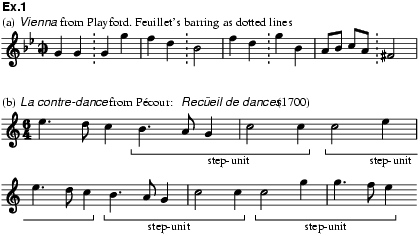
(Fr.; Ger. Contratanz, Kontretanz; It., Sp. contradanza).
The most popular French dance of the 18th century. Its development was stimulated by the English country dance introduced at the French court in the 1680s, as seen in André Lorin's two manuscripts on the country dance (c1686 and 1688) presented to Louis XIV. Its gaiety and the novelty of its democratically progressive pattern appealed to the younger generation, so that French dancing-masters were soon composing dances in the English style. They did not attempt to translate the English name but merely pronounced it in the French manner. English tunes were imported along with the dance form; according to the Swiss Béat de Muralt, ‘Les airs sont d’une vivacité qui émeut l’âme’. Feuillet’s Recüeil de contredances (Paris, 1706/R) contains many English dances: Greensleeves appears as Les manches vertes and Christ Church Bells as Le carillon d’Oxfort. Dance figures were sometimes altered, or the time pattern of the tune changed, as in ex.1a.

The 17th-century English country dance included dances in circle, square and longways formations. By the end of the century, the longways dance had become the preferred type and was adopted by the French. The ingenuity of English figure dancing was much admired: the figures were executed with any suitable steps familiar to the company or chosen by individual dancers. The choice of steps was therefore affected by fashion: Feuillet and Essex suggested the gavotte, chassé, pas de bourée and petit saut, while country-dance tunes were also set in minuet, courante and gigue rhythms. French taste tended towards regularity, whereas the English favoured variety and individuality. Thus Lorin indicated the steps for each figure of a dance, while Feuillet and English publications gave general advice, leaving the dancers scope to improvise. Another important element of French style was dancing across the bar, either throughout a dance by treating the first half-bar as an anacrusis or as a rhythmic contrast within the dance. This feature shows clearly in La contre-dance, a couple-dance by Pécour for theatre or ballroom to an air by Lully (ex.1b).
The native French dance Le cotillon (a square dance for two couples) was subsumed into the contredanse genre, and then returned to England as the cotillion in the early 18th century. The dance-tune appears in The Beggar’s Opera (1728), where Macheath refers to it as ‘the French tune that Mrs Slammekin was so fond of’ (ex.2). Stage directions here call for ‘A Dance a la ronde in the French Manner’.
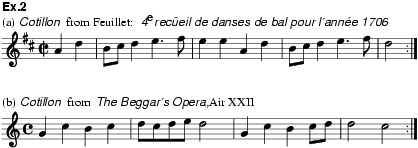
The contredanse (as a cotillon for four couples) reached its most highly developed form in the mid-18th century. An elaborate figure was danced nine times, each repetition preceded by a different introduction; this required a tune with two repeated sections: the first, of eight bars, for the introductions; the second, of eight bars or more, for the figure (see illustration). The tunes are in duple rhythm (2/4 or 6/8) and often begin at the half-bar (ex.3). Major tonality predominates, though an alternative tune in the tonic minor often provides variety. The monotony of nine repetitions of the figure was sometimes relieved by the introduction of alternative figures in contrasting rhythms; this was called a ‘potpourri’.
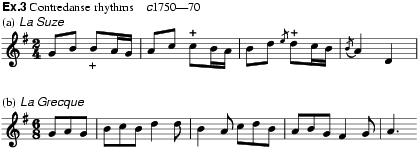
La Cuisse, in Le repertoire des bals, ou Théorie pratique des contredanses (Paris, 1762–5/R), explained that the French army’s years in Germany had popularized movements with arms interlaced in the German style; consequently many figures at this time included such movements and were described as ‘contredanses allemandes’. The name ‘anglaise’, originally denoting the longways progressive pattern, was now also used when the figure was danced mainly in two lines. The contredanse was soon the most popular dance in French urban society, at the expense of the minuet. Its popularity remained undiminished under Louis XVI and during the Revolution, but the figures became simpler and more stereotyped, until it was replaced by the quadrille. Mozart's contredanse rhythms make themselves felt in his serious music, and he was pleased to find tunes from Le nozze di Figaro used in the ballroom. The final movements of his string quintets provide good examples and may be compared with the music he wrote for actual dancing (ex.4). Many lively pieces in major keys and 2/4 or 6/8 metre written at this time, with the clearcut melody and eight-bar phrases common in the period, tend to sound like contredanses whether or not the intention was conscious.
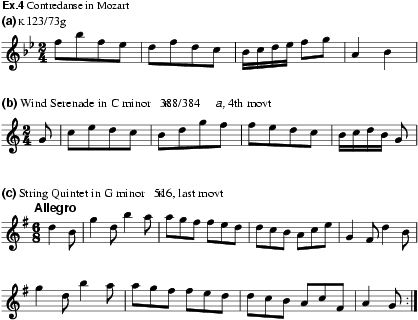
Early 19th-century dance-tunes show a predilection for ‘reel’ rhythm, and Beethoven followed this trend in his 12 Contredanses for orchestra (1802). The similarity between them and some surviving European dance-tunes makes an interesting comparison (ex.5). The contredanse continued to hold its own until about 1840, when it finally gave way to the new round dances of the waltz and polka.
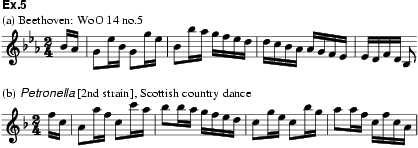
See also Anglaise; Ecossaise; and Quadrille.
MGG1 (C. Marcel-Dubois)
MGG2 (‘Country Dance, Contredanse’; S. Dahms)
G. Magri: Trattato teorico: prattico di ballo (Naples, 1779; Eng. trans., 1988)
M. Wood: Some Historical Dances (Twelfth to Nineteenth Century): their Manner of Performance and their Place in the Social Life of the Time (London, 1952) [incl. arrs. of dances for pf]
H. Besseler: ‘Einflüsse der Contratanzmusik auf Joseph Haydn’, Konferenz zum Andenken Joseph Haydns: Budapest 1959, 25–40
J.-M. Guilcher: La contredanse et les renouvellements de la danse française (Paris, 1969)
G. Plant and L. Pleydell: ‘Lorin’s Introduction to First Book of Contredances [c.1686]’, Historical Dance, ii/2 (1982), 3–13
L. and C. Flagel: Le bal des citoyens: danses et contradanses de la Révolution (Brussels, 1989)
M. Clark: ‘The Contredanse, that Musical Plague’, Border Crossings: Dance and Boundaries in Society, Politics, Gender, Education, and Technology: Toronto 1995, ed. L.J. Tomko (Riverside, CA, 1995), 61–70
R. Semmens: ‘Branles, Gavottes and Contredanses in the Later Seventeenth and Early Eighteenth Centuries’, Dance Research, xv/2 (1997), 35–62
FREDA BURFORD/ANNE DAYE